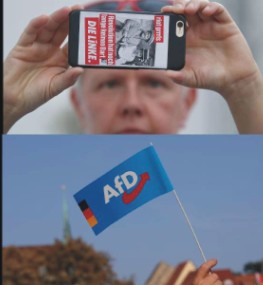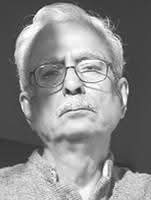
The political centre has been the main force behind the introduction of the neoliberal order and, as disillusionment with this order rises, people’s anger gets directed against the political centre
The recent German election results confirm a trend observable for some time, at least in advanced capitalist countries, namely, the collapse of the political centre, comprising both Centre-Left and Centre-Right, and the rise in its place of the Right and the Left. This was visible in France recently where a united Left got the largest number of seats in Parliament, even beating the tally of Marine Le Pen’s extreme-Right; the biggest loser was the Centrist formation of President Emmanuel Macron. Even in Britain, where the Tories lost heavily in the last election, it is not Labour that benefited from this loss; though Labour came to office as a result, the real gainer was the extreme-Right Reform Party.
In Germany likewise, the loss in the percentage share of votes for the earlier ruling coalition, comprising the Social Democrats, the Free Democrats and the Greens, was as much as 19.5% between 2021 and 2025 but the increase in the vote-share of the Centre-Right Christian Democratic Union-Christian Social Union was only 4.4%. The real gainers were the neo-fascist AfD, which got 10.4% more votes than that in 2021, and the Left, comprising both Die Linke and the breakaway group under Sahra Wagenknecht, which got 8.87% more votes than in 2021.
While the rise of the AfD in these elections has been widely noted, the success of the Left has generally gone unnoticed. The Left party, Die Linke, which is a successor to the Socialist Unity Party that ruled the German Democratic Republic until reunification, had earlier got its highest vote share, 11.9%, in 2005. There was a split in Die Linke recently with one of its leaders, Wagenknecht, breaking away from the parent party mainly due to differences over NATO and the Ukraine war. But if one adds up the votes of the two groups together, then it comes to almost 14% (13.98%), which is the highest percentage the Left has ever got since German reunification. In comparison, the AfD got 20.8%, the SPD 16.4% and the CDU-CSU 28.6%. In short, it is not just the AfD but the Left too that did well in these elections, while parties of the political centre taken together did relatively poorly.
This decline of the political centre is the political expression of the crisis of neoliberalism that currently afflicts the capitalist world. The political centre has been the main force behind the introduction of the neoliberal order and, as disillusionment with this order rises, people’s anger gets directed against the political centre. To be sure, the neo-fascists, which gain from such anger by seemingly standing apart from neoliberalism when in opposition, embrace it when they come to power, as Giorgia Meloni has done in Italy (India’s Narendra Modi, however, never stood apart). This initial oppositional stance helps them electorally; but their specific appeal lies elsewhere: in changing the discourse by ‘Othering’ a hapless minority and fomenting hatred against it within the majority.
The fact that even before the pandemic the decadal GDP growth rate of the world economy was the lowest for the decade ending 2019 among all post-War decades indicates the magnitude of the crisis. The pandemic and the subsequent years have only worsened the situation for the working people, and neo-fascists like Donald Trump have benefitted from this.
The point being made is that compared to the neo-fascists who operate within neoliberalism but with a radically different discourse, and the Left that holds out the promise of transcending neoliberalism, parties of the political centre have little to offer to the electorate. They embrace neoliberalism and, hence, in effect its crisis despite the hardships it imposes on the people; and this explains their decline.
Perhaps one can see in the European political centre’s strident Russophobia an effort to overcome this handicap; it is conjuring up an external threat and presenting itself as the only force capable of dealing with it. Both the Left and the Right, by contrast, appear less concerned about it. These claims of European centrist parties about Russia’s aggressive designs are quite baseless, rather reminiscent of Cold War propaganda about the Soviet threat to Europe. In fact, the Columbia University professor, Jeffrey Sachs, debunked these claims in a speech to the European Parliament, even calling them “childish”. Russia, he underscored, had itself once mooted the idea of joining NATO, but this idea was rebuffed by the then US president, Bill Clinton. It would have been in conformity, though, with the Europhilic tradition within Russia that was represented by Mikhail Gorbachev.
The claims about Russia’s aggressiveness also provide European centrist parties a possible opportunity for attempting a Keynesian solution to the crisis by increasing State expenditure through a larger fiscal deficit. Normally a larger fiscal deficit would be opposed by globalised finance which would leave the country causing a financial crisis; but a larger fiscal deficit to finance military expenditure to counter the Russian threat, it is hoped by its advocates, would not induce finance to leave the country en masse.
Germany has very recently attempted to overturn a constitutionally-existing brake on government debt so that more can be spent on armaments and infrastructure through a larger fiscal deficit. It is obviously a desperate attempt for it has used an about-to-expire Parliament to achieve its goal (the newly-elected Parliament might not have given the Centrist parties the required majority for enacting a constitutional amendment). How far it stimulates the economy compared to its present state remains unclear as its effect would be partly offset by Donald Trump’s tariffs; but German militarisation constitutes a frightening prospect.
Prabhat Patnaik is Professor Emeritus, Centre for Economic Studies, Jawaharlal Nehru University, New Delhi ( Courtesy The Telegraph )







